
Left: mLg computed using the IASPEI formula. Center: mLg residuals versus epicentral distance ; the values used for the trimmed mean magnitude estimate are indicated. Right: residuals as a function of distance and azimuth.
The ANSS event ID is ak0195nlynig and the event page is at https://earthquake.usgs.gov/earthquakes/eventpage/ak0195nlynig/executive.
2019/05/03 11:52:25 66.226 -157.184 5.7 4 Alaska
USGS/SLU Moment Tensor Solution
ENS 2019/05/03 11:52:25:0 66.23 -157.18 5.7 4.0 Alaska
Stations used:
AK.ANM AK.BPAW AK.BWN AK.CAST AK.CCB AK.COLD AK.CUT AK.FYU
AK.HDA AK.KTH AK.MCK AK.MLY AK.NEA2 AK.PPD AK.PPLA AK.RDOG
AK.RND AK.SKN AK.TNA AK.TRF AK.WRH AV.STLK IM.IL31 IU.COLA
TA.C18K TA.D19K TA.D20K TA.D22K TA.D23K TA.D24K TA.E18K
TA.E19K TA.E22K TA.E23K TA.E25K TA.F15K TA.F17K TA.F19K
TA.F21K TA.F24K TA.F25K TA.F26K TA.G18K TA.G21K TA.G23K
TA.G24K TA.G26K TA.H17K TA.H18K TA.H19K TA.H21K TA.H23K
TA.H24K TA.I17K TA.I20K TA.I23K TA.J14K TA.J16K TA.J17K
TA.J18K TA.J19K TA.J20K TA.J25K TA.K15K TA.K17K TA.K20K
TA.L16K TA.L18K TA.L19K TA.M16K TA.M17K TA.POKR TA.TOLK
Filtering commands used:
cut o DIST/3.3 -40 o DIST/3.3 +50
rtr
taper w 0.1
hp c 0.03 n 3
lp c 0.08 n 3
Best Fitting Double Couple
Mo = 1.84e+22 dyne-cm
Mw = 4.11
Z = 10 km
Plane Strike Dip Rake
NP1 165 90 20
NP2 75 70 180
Principal Axes:
Axis Value Plunge Azimuth
T 1.84e+22 14 32
N 0.00e+00 70 165
P -1.84e+22 14 298
Moment Tensor: (dyne-cm)
Component Value
Mxx 8.65e+21
Mxy 1.50e+22
Mxz 1.63e+21
Myy -8.65e+21
Myz 6.08e+21
Mzz -5.50e+14
--############
------#############
----------############ T ###
-----------############ ####
--------------####################
- -----------#####################
-- P ------------#####################
--- ------------######################
-------------------####################-
--------------------##################----
---------------------###############------
---------------------############---------
----------------------#######-------------
---------------------#------------------
####---------#########------------------
#####################-----------------
#####################---------------
####################--------------
###################-----------
##################----------
################------
############--
Global CMT Convention Moment Tensor:
R T P
-5.50e+14 1.63e+21 -6.08e+21
1.63e+21 8.65e+21 -1.50e+22
-6.08e+21 -1.50e+22 -8.65e+21
Details of the solution is found at
http://www.eas.slu.edu/eqc/eqc_mt/MECH.NA/20190503115225/index.html
|
STK = 165
DIP = 90
RAKE = 20
MW = 4.11
HS = 10.0
The NDK file is 20190503115225.ndk The waveform inversion is preferred.
Given the availability of digital waveforms for determination of the moment tensor, this section documents the added processing leading to mLg, if appropriate to the region, and ML by application of the respective IASPEI formulae. As a research study, the linear distance term of the IASPEI formula for ML is adjusted to remove a linear distance trend in residuals to give a regionally defined ML. The defined ML uses horizontal component recordings, but the same procedure is applied to the vertical components since there may be some interest in vertical component ground motions. Residual plots versus distance may indicate interesting features of ground motion scaling in some distance ranges. A residual plot of the regionalized magnitude is given as a function of distance and azimuth, since data sets may transcend different wave propagation provinces.

Left: mLg computed using the IASPEI formula. Center: mLg residuals versus epicentral distance ; the values used for the trimmed mean magnitude estimate are indicated.
Right: residuals as a function of distance and azimuth.

Left: ML computed using the IASPEI formula for Horizontal components. Center: ML residuals computed using a modified IASPEI formula that accounts for path specific attenuation; the values used for the trimmed mean are indicated. The ML relation used for each figure is given at the bottom of each plot.
Right: Residuals from new relation as a function of distance and azimuth.

Left: ML computed using the IASPEI formula for Vertical components (research). Center: ML residuals computed using a modified IASPEI formula that accounts for path specific attenuation; the values used for the trimmed mean are indicated. The ML relation used for each figure is given at the bottom of each plot.
Right: Residuals from new relation as a function of distance and azimuth.
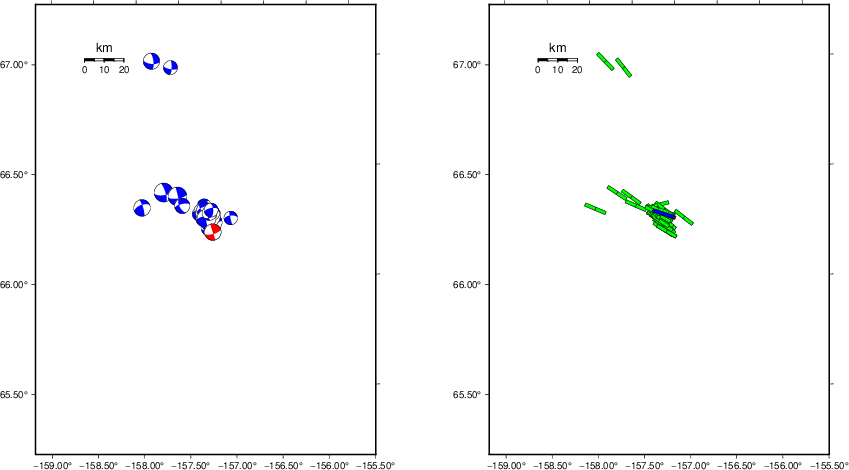 |
The focal mechanism was determined using broadband seismic waveforms. The location of the event (star) and the stations used for (red) the waveform inversion are shown in the next figure.
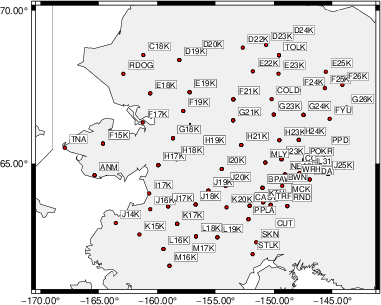
|
|
|
The program wvfgrd96 was used with good traces observed at short distance to determine the focal mechanism, depth and seismic moment. This technique requires a high quality signal and well determined velocity model for the Green's functions. To the extent that these are the quality data, this type of mechanism should be preferred over the radiation pattern technique which requires the separate step of defining the pressure and tension quadrants and the correct strike.
The observed and predicted traces are filtered using the following gsac commands:
cut o DIST/3.3 -40 o DIST/3.3 +50 rtr taper w 0.1 hp c 0.03 n 3 lp c 0.08 n 3The results of this grid search are as follow:
DEPTH STK DIP RAKE MW FIT
WVFGRD96 1.0 170 85 0 3.72 0.3814
WVFGRD96 2.0 165 90 5 3.84 0.5122
WVFGRD96 3.0 165 90 15 3.90 0.5686
WVFGRD96 4.0 165 90 20 3.94 0.6105
WVFGRD96 5.0 165 90 20 3.98 0.6417
WVFGRD96 6.0 165 90 20 4.01 0.6673
WVFGRD96 7.0 165 90 20 4.04 0.6888
WVFGRD96 8.0 165 90 20 4.07 0.7088
WVFGRD96 9.0 165 90 20 4.09 0.7169
WVFGRD96 10.0 165 90 20 4.11 0.7199
WVFGRD96 11.0 345 90 -15 4.12 0.7197
WVFGRD96 12.0 165 90 15 4.14 0.7167
WVFGRD96 13.0 165 90 15 4.15 0.7111
WVFGRD96 14.0 165 90 15 4.16 0.7029
WVFGRD96 15.0 165 90 15 4.17 0.6934
WVFGRD96 16.0 345 85 -10 4.18 0.6830
WVFGRD96 17.0 345 85 -10 4.19 0.6722
WVFGRD96 18.0 165 90 10 4.20 0.6586
WVFGRD96 19.0 165 90 10 4.21 0.6460
WVFGRD96 20.0 345 85 -10 4.22 0.6354
WVFGRD96 21.0 345 85 -10 4.22 0.6225
WVFGRD96 22.0 165 90 10 4.23 0.6085
WVFGRD96 23.0 345 85 -10 4.23 0.5973
WVFGRD96 24.0 165 90 10 4.24 0.5830
WVFGRD96 25.0 345 85 -10 4.24 0.5719
WVFGRD96 26.0 345 85 -10 4.25 0.5597
WVFGRD96 27.0 345 85 -10 4.25 0.5479
WVFGRD96 28.0 345 85 -10 4.26 0.5365
WVFGRD96 29.0 165 90 10 4.26 0.5261
The best solution is
WVFGRD96 10.0 165 90 20 4.11 0.7199
The mechanism corresponding to the best fit is
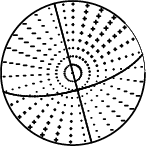
|
|
|
The best fit as a function of depth is given in the following figure:
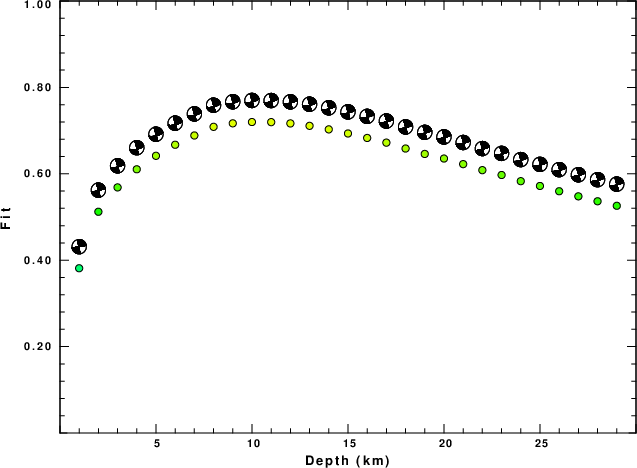
|
|
|
The comparison of the observed and predicted waveforms is given in the next figure. The red traces are the observed and the blue are the predicted. Each observed-predicted component is plotted to the same scale and peak amplitudes are indicated by the numbers to the left of each trace. A pair of numbers is given in black at the right of each predicted traces. The upper number it the time shift required for maximum correlation between the observed and predicted traces. This time shift is required because the synthetics are not computed at exactly the same distance as the observed, the velocity model used in the predictions may not be perfect and the epicentral parameters may be be off. A positive time shift indicates that the prediction is too fast and should be delayed to match the observed trace (shift to the right in this figure). A negative value indicates that the prediction is too slow. The lower number gives the percentage of variance reduction to characterize the individual goodness of fit (100% indicates a perfect fit).
The bandpass filter used in the processing and for the display was
cut o DIST/3.3 -40 o DIST/3.3 +50 rtr taper w 0.1 hp c 0.03 n 3 lp c 0.08 n 3

|
| Figure 3. Waveform comparison for selected depth. Red: observed; Blue - predicted. The time shift with respect to the model prediction is indicated. The percent of fit is also indicated. The time scale is relative to the first trace sample. |
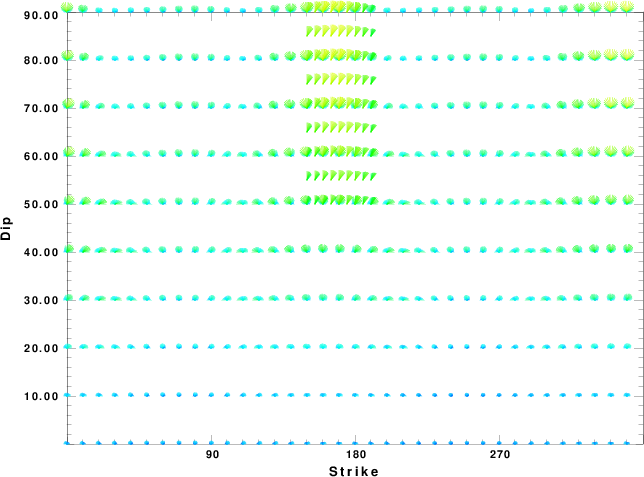
|
| Focal mechanism sensitivity at the preferred depth. The red color indicates a very good fit to the waveforms. Each solution is plotted as a vector at a given value of strike and dip with the angle of the vector representing the rake angle, measured, with respect to the upward vertical (N) in the figure. |
A check on the assumed source location is possible by looking at the time shifts between the observed and predicted traces. The time shifts for waveform matching arise for several reasons:
Time_shift = A + B cos Azimuth + C Sin Azimuth
The time shifts for this inversion lead to the next figure:
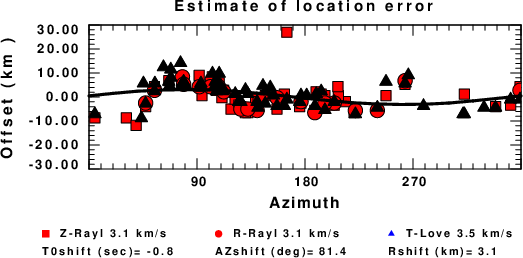
The derived shift in origin time and epicentral coordinates are given at the bottom of the figure.
The WUS.model used for the waveform synthetic seismograms and for the surface wave eigenfunctions and dispersion is as follows (The format is in the model96 format of Computer Programs in Seismology).
MODEL.01
Model after 8 iterations
ISOTROPIC
KGS
FLAT EARTH
1-D
CONSTANT VELOCITY
LINE08
LINE09
LINE10
LINE11
H(KM) VP(KM/S) VS(KM/S) RHO(GM/CC) QP QS ETAP ETAS FREFP FREFS
1.9000 3.4065 2.0089 2.2150 0.302E-02 0.679E-02 0.00 0.00 1.00 1.00
6.1000 5.5445 3.2953 2.6089 0.349E-02 0.784E-02 0.00 0.00 1.00 1.00
13.0000 6.2708 3.7396 2.7812 0.212E-02 0.476E-02 0.00 0.00 1.00 1.00
19.0000 6.4075 3.7680 2.8223 0.111E-02 0.249E-02 0.00 0.00 1.00 1.00
0.0000 7.9000 4.6200 3.2760 0.164E-10 0.370E-10 0.00 0.00 1.00 1.00